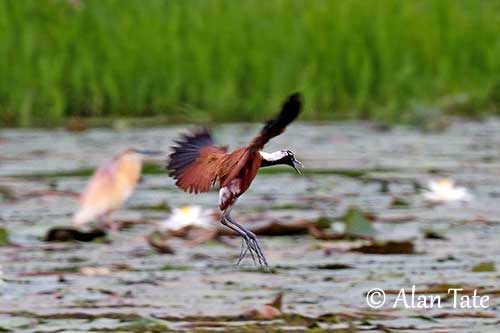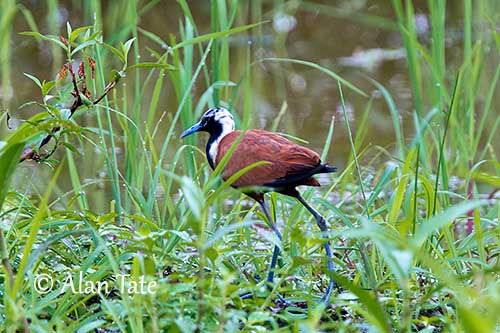
Fr: Jacana malgache
Ang: Madagascan Jacana
All: Madagaskarblatthühnchen
Esp: Jacana Malgache
Ita: Jacana del Madagascar
Nd: Madagaskarjacana
Sd: madagaskarjaçana
Mal: Fandionga, Piritry, Tsikai
Photographers:
Alan & Ann Tate
AA Bird Photography
Text by Nicole Bouglouan
Sources:
HANDBOOK OF THE BIRDS OF THE WORLD Volume 3 by Josep del Hoyo-Andrew Elliott-Jordi Sargatal - Lynx Edicions - ISBN : 8487334202
The Birds of Africa: Volume VIII: The Malagasy Region: Madagascar, Seychelles, Comoros, Mascarenes - Par Roger Safford, Frank Hawkins – ISBN: 1408190494, 9781408190494- Editeur: A&C Black, 2013
Wildlife of Madagascar par Ken Behrens,Keith Barnes - ISBN: 140088067X, 9781400880676 – Editeur: Princeton University Press, 2016
Birds of Madagascar: A Photographic Guide Par Pete Morris, Frank Hawkins – ISBN: 0300077556, 9780300077551- Editeur: Yale University Press, 1998
Birds of the Indian Ocean Islands Par Ian Sinclair, Olivier Langrand - ISBN: 1868729567, 9781868729562- Editeur: Struik, 2003
Madagascan Jacana
Actophilornis albinucha
Charadriiformes Order – Jacanidae Family
INTRODUCTION:
The Madagascan Jacana is endemic to Madagascar where it frequents freshwater marshes, ponds and marshy bays, from sea-level to 750 metres of elevation. This species is mainly found in W and N of the island.
This is a graceful bird walking over the floating vegetation. It is very similar in appearance and general habits to the African Jacana. It is usually associated with water lilies, and avoids the brackish waters where this plant does not grow.
The Madagascan Jacana is threatened by habitat loss and degradation through conversion of aquatic areas to rice cultivation. The species is able to survive in modified and disturbed habitats, but it is also threatened by illegal hunting. It is currently considered Near Threatened.

DESCRIPTION OF THE BIRD:
Biometrics:
Length: 30 cm
Weight of one female: 239 g
The Madagascan Jacana is very similar to the African Jacana, but it has white crown, hindneck and neck sides with some golden yellow wash at upper edge of mantle. Face, chin, throat and lower foreneck are black. The crown is flecked black.
Body and wings are chestnut except for a white band extending from thighs to uppertail-coverts. On the tail, the central rectrices are tipped black. Outer secondary and primary flight-feathers are blackish. The underwing is chestnut.
Bill and frontal shield are pale blue. The eyes are brown. Long legs and feet are blue-grey.
Male and female have similar plumage, but the female is larger, with longer wings and tail.
The juvenile is almost similar to juvenile African Jacana but with blacker crown, hindneck and eye stripe. The underparts are white with golden wash on breast and pale chestnut tinge on flanks and belly. The upperparts are like in adults. The bill-shield is small.
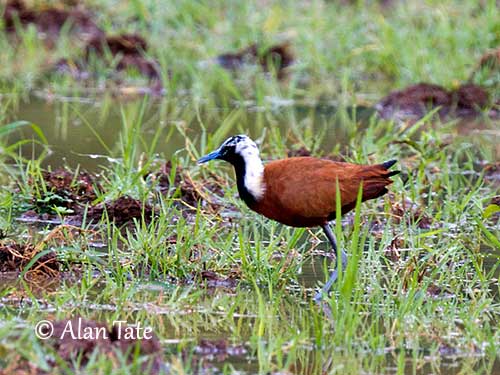
RANGE:
The Madagascan Jacana is mainly found in W and N Madagascar and usually in lowlands. It is absent from the central plateau and the driest parts of S and SW, and it is rare in the E with only few records.
HABITAT:
The Madagascan Jacana frequents freshwater wetlands with extensive floating vegetation, and especially water lilies. It can be seen on lakes, ponds and along slow-flowing rivers, and in marshy bays.
It is absent from brackish waters where water lilies do not grow. The species is visible from sea-level up to 750 metres of elevation.
CALLS AND SONGS: SOUNDS BY XENO-CANTO
The Madagascan Jacana gives sharp calls which reduce in volume during quarrels “kreeeee-kreee-kreee”. It also utters a medium-pitched trilled “trrrt…trrrt…trrt” given in long sequences, rising and descending and varying in speed. This call is often given by several birds together, apparently in display.
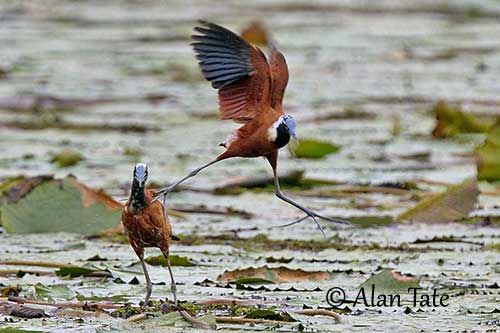
BEHAVIOUR IN THE WILD:
The Madagascan Jacana feeds primarily on insects and larvae, various other invertebrates and seeds of aquatic plants.
It forages over the floating vegetation while gleaning prey, picking them from the roots of floating plants. It forages by walking in normal upright posture, also searching for food with bill and head lowered. It is able to walk quickly on the floating vegetation, thanks to its long toes and claws.
The Madagascan Jacana is usually seen alone or in pairs. They may form loose groups outside the breeding season, from some tens to exceptionally up to 76 birds.
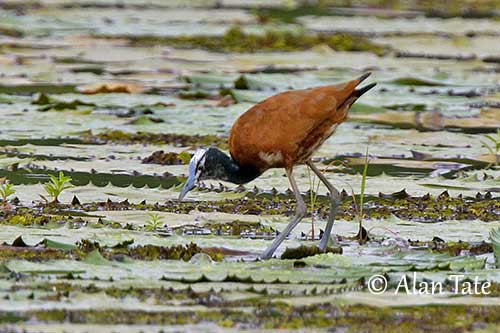
During the breeding season, the Madagascan Jacanas exhibit sexual role reversal and polyandrous mating system. The male usually does most of all nesting duties, including nest-building, incubation, brooding and rearing chicks. The female performs predator defence and holds the territory against other females that could copulate with the male. She may mate with two or more males.
The courtship behaviour is poorly known. Sexual solicitation is observed with the male mimicking the female’s posture, often considered part of courtship behaviour. They may make short, hovering display flights too. But more information is required.
The Madagascan Jacana probably performs local movements within its range, related with water levels.
Like other jacanas, it is a weak flier. Over short distances, the long legs and feet are dangling, but in more prolonged flight, legs and feet trail behind body and tail. When alighting, the bird extends the wings vertically over the body, holding this posture briefly before folding them.
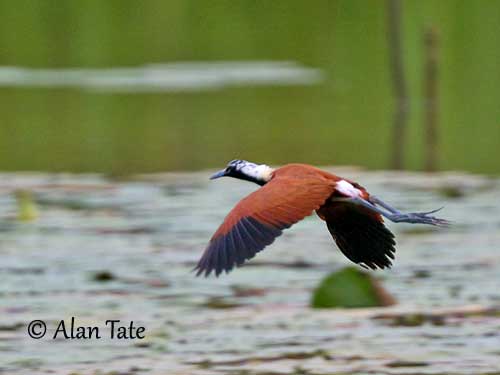
REPRODUCTION OF THIS SPECIES:
The Madagascan Jacana appears to breed throughout the year, but according to some observations such as adults in breeding condition, nests with eggs and downy chicks, the breeding season may occur between December and June, with the laying between March and June/July.
The nest built by the male is a floating mass of aquatic vegetation. The mass of this structure is often beneath the water surface, making the nest inconspicuous. The male adds plant material grasped around the nest during the incubation.
One clutch of 4 eggs has been reported. The glossy eggs are deep olive-buff with irregular darker lines. The incubation is made by the male alone and is reported to last roughly 22-28 days. The female is not known to incubate.
The chicks have black crown, hindneck and lores. The upperparts are cinnamon-buff with rusty-brown streaks, whereas the underparts, head and neck sides are whitish. The young are accompanied by the male to the feeding areas. Replacement clutch occurs if the first attempt fails.
PROTECTION / THREATS / STATUS:
The Madagascan Jacana is threatened by habitat loss and degradation due to agriculture expansion, drainage of wetlands and illegal hunting. The wetlands suffer conversion to rice-plantations that reduce the habitat.
The species is able to survive in modified and disturbed habitats such as flooded ricefields, but this is currently unclear and the species is more abundant on nearby lakes.
The population is estimated to number 1,000/10,000 individuals, equating roughly to 670/6,700 mature individuals. This population is declining slowly due to the previous threats.
The Madagascan Jacana is currently listed as Near Threatened.
